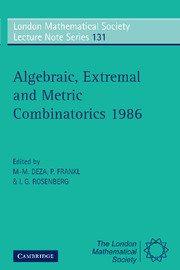Book contents
- Frontmatter
- Contents
- Introduction
- List of Talks
- Participants
- Some Recent Combinatorial Applications of Borsuk-Type Theorems
- On Extremal Finite Sets in the Sphere and Other Metric Spaces
- Metric and Geometric Properties of Sets of Permutations
- Infinite Geometric Groups and Sets
- Intersection and Containment Problems Without Size Restrictions
- Distance-Transitive Graphs of Valency k, 8 ≤ k ≤ 13
- Latin Square Determinants
- A Computer Search for a Projective Plane of Order 10
- Matroids, Algebraic and Non Algebraic
- Algebraic Properties of a General Convolution
- Quasi Groups, Association Schemes, and Laplace Operators on Almost Periodic Functions
- Geometric Methods in Group Theory
- Problem Section
A Computer Search for a Projective Plane of Order 10
Published online by Cambridge University Press: 05 April 2013
- Frontmatter
- Contents
- Introduction
- List of Talks
- Participants
- Some Recent Combinatorial Applications of Borsuk-Type Theorems
- On Extremal Finite Sets in the Sphere and Other Metric Spaces
- Metric and Geometric Properties of Sets of Permutations
- Infinite Geometric Groups and Sets
- Intersection and Containment Problems Without Size Restrictions
- Distance-Transitive Graphs of Valency k, 8 ≤ k ≤ 13
- Latin Square Determinants
- A Computer Search for a Projective Plane of Order 10
- Matroids, Algebraic and Non Algebraic
- Algebraic Properties of a General Convolution
- Quasi Groups, Association Schemes, and Laplace Operators on Almost Periodic Functions
- Geometric Methods in Group Theory
- Problem Section
Summary
ACKNOWLEDGEMENT
This work was supported by the Natural Sciences and Engineering Research Council of Canada under Grants A9373, 0011 and by the Fonds pour la Formation de Chercheurs et l'Aide á la Recherche under Grant EQ2369.
INTRODUCTION
A finite projective plane of order n is a collection of n2+n+1 lines and n2+n+1 points such that
(1.1) every line contains n+1 points,
(1.2) every point is on n+1 lines,
(1.3) any two distinct lines intersect at exactly one point, and
(1.4) any two distinct points lie on exactly one line.
For example, a projective plane of order 2 is shown in Fig. 1. It has 7 points and 7 lines. The points are numbered from 1 to 7. The 7 lines are L1 = {1,2,4}, L2= {2,3,5}, L3 = {3,4,6}, L4= {4,5,7}, L5 {1,5,6}, L6 {2,6,7} and L7 = {1,3,7}. In Fig. 1 all the lines except L6 are drawn as straight lines. One can easily show that this projective plane of order 2 is unique up to the relabelling of points and lines.
Another way to represent a projective plane is to use an incidence matrix A of size n2 +n+ 1 by n2+n+1.
- Type
- Chapter
- Information
- Algebraic, Extremal and Metric Combinatorics 1986 , pp. 155 - 165Publisher: Cambridge University PressPrint publication year: 1988
- 2
- Cited by



